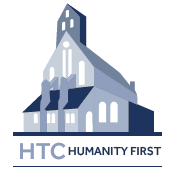Throughout this evaluation many of the case studies provided could have been placed either under the SPY Project or under the later Holy Trinity Church and Community Centre Project. Each of the Case Studies has been placed where the greatest impact was felt. Where the studies have no specific attribution, they have been prepared through interviews by Margaret Stanley a member of the Management Committee of HTCC:
1. FAST Club Summer Activities, in partnership with Holy Trinity C of E Primary School and St. Peter’s C of E Primary School.
The FAST Club brings together a 98% Asian school, Holy Trinity and a majority white school, St. Peter’s, with the highest percentage of ‘looked after’ children in Tameside, it continues to work in 2016 to promote greater community cohesion.
SPY organised for children from the FAST Club (Families and School Together), whose main facilities are based at Holy Trinity School, to get involved in lots of activities over the summer holidays. As part of that, they worked hard on a project that contributed to community life. The project was to improve the FAST Club headquarters.
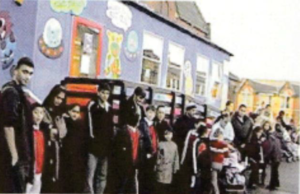 Kathleen Menmuir, then Headteacher at Holy Trinity C of E Primary School said, “I have been amazed at the transformation of the mobile classroom which the children had worked hard on over the summer. We have had many positive comments from members of the community and especially from our neighbours on Kenyon Street. Neighbours are saying that they have had a lovely summer, as there has been no vandalism or noise from children roaming the streets. The FAST club has really kept our children happy and engaged all through the summer holidays”
Kathleen Menmuir, then Headteacher at Holy Trinity C of E Primary School said, “I have been amazed at the transformation of the mobile classroom which the children had worked hard on over the summer. We have had many positive comments from members of the community and especially from our neighbours on Kenyon Street. Neighbours are saying that they have had a lovely summer, as there has been no vandalism or noise from children roaming the streets. The FAST club has really kept our children happy and engaged all through the summer holidays”
Other projects that SPY engaged the young people in included a ‘Stand Up Speak Up’ event and half term activities dedicated to ‘St. Peter’s United Against Racism’. This saw more than 100 children and their families parade their banners at Gigg Lane Football Stadium, the then home of ‘FC United’, wearing their United Against Racism T-shirts.
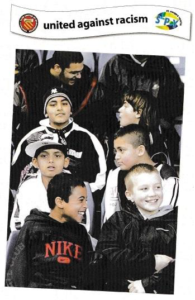 Community Cohesion
Community Cohesion
The local publication entitled ‘Every Child Matters’ commented that this project directly addressed Community Cohesion:
“Common sense dictates the bringing together of young people from one school which is 98% Asian (Holy Trinity) and St. Peter’s which is 67% White with the highest percentage of looked after children in the Borough, in activities that are directly linked to community cohesion, which are anti-racist and inclusive, with some of the most difficult to reach pupils from each of the schools in holiday activities, extra curriculum activities and opportunities to celebrate the collective achievements must develop a greater opportunity for social contact with groups they would not normally socialise with.”
2. Be Healthy and ‘Summer Splash’
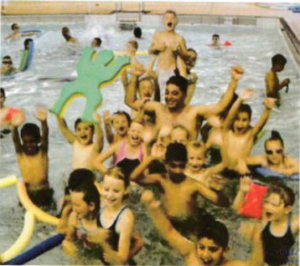 Over one summer SPY delivered a summer programme that saw hundreds of young people enjoy a range of sporting activities, which also included the very successful “summer splash” swimming initiative. Summer Splash saw 70 young people and their families enjoy swimming lessons at Ashton Baths.
Over one summer SPY delivered a summer programme that saw hundreds of young people enjoy a range of sporting activities, which also included the very successful “summer splash” swimming initiative. Summer Splash saw 70 young people and their families enjoy swimming lessons at Ashton Baths.
Ofsted commented on the whole programme: ‘The promotion of a healthy lifestyle and the encouragement pupils get to make a positive contribution to the community are good. Guidance and support given to pupils who are in the early stages of learning English are excellent as is the support given to their parents.
The Summer Splash programme was designed to keep young people safe in and around water and provided parents with essential first aid skills. The sessions also promoted good health by encouraging young people to enjoy physical activity and also provided them with a healthy snack too! Councillor Jack Davis said, “It was brilliant to see young people from our community learning, playing and achieving together. We have struggled in the past to get pool time and would like to thank Tameside Sports Trust for their support. … It proves just what can be achieved when partners work together to meet community need.”
Kevin Pietersen, the England Cricket star was so impressed with the work to promote community cohesion and sport as a way of bringing young people and communities together, he donated an autographed cricket bat. Carl Kelsall, Youth Strategy Manager at the time, said, “It has been impossible to decide on which young person should receive the bat from the hundreds that took part in the activities. We have decided it should go on display at the new £1.9 million Community and Sports Centre on Oxford Park – this will be a permanent reminder of the success of this summer. It’s very easy for us all to recognise the negative behaviour of young people, we notice it because it affects the quality of our life. It is essential that we all begin to recognise good behaviour and provide opportunity for them to enjoy and achieve and publicly celebrate their achievements. Seeing young people being praised by workers, neighbours and peers sends out the right messages that if we provide opportunity to do the right thing, young people will.”
3. Youth In Action Learning (2012)
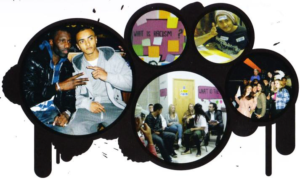 SPY were funded by Youth in Action and Tameside MBC to deliver an exciting, unique programme to work with 30 young people over 12 months to explore their identity and community and to begin a meaningful uncensored dialogue about the issues preventing real cohesion. Ultimately 45 young people got involved with the programme, 34 male and 11 female. The group came from the St. Peter’s and Holy Trinity areas and were from British White, Pakistani, Bengali, Thai and Kosovan ethnicities.
SPY were funded by Youth in Action and Tameside MBC to deliver an exciting, unique programme to work with 30 young people over 12 months to explore their identity and community and to begin a meaningful uncensored dialogue about the issues preventing real cohesion. Ultimately 45 young people got involved with the programme, 34 male and 11 female. The group came from the St. Peter’s and Holy Trinity areas and were from British White, Pakistani, Bengali, Thai and Kosovan ethnicities.
Risks were taken to open up contentious and sensitive subjects on race, identity, culture and Britishness. It was an incredible journey for young people and staff alike.
We looked at our identity through discussions, debates, music, games and photography. Debates were often heated but ultimately agreement was reached that blame, hate and war do not solve problems and probably make terrorism more prevalent.
 We learnt that young people have to know their identity and be comfortable with themselves first. The strength in the BME young people was their strong, cultural and religious identity which made them much more resilient to the effects of exclusion and poverty. In contrast the white young people felt they didn’t know their history or culture and felt being proud of being white British makes you seem racist in our society. Their anger stemmed from this feeling of being taken over and Britishness being lost.
We learnt that young people have to know their identity and be comfortable with themselves first. The strength in the BME young people was their strong, cultural and religious identity which made them much more resilient to the effects of exclusion and poverty. In contrast the white young people felt they didn’t know their history or culture and felt being proud of being white British makes you seem racist in our society. Their anger stemmed from this feeling of being taken over and Britishness being lost.
We explored other factors that have changed Britain such as economic conditions, poverty and unemployment which have affected us regardless of our ethnicity. We discovered that things are still volatile between the two areas of St. Peter’s and Holy Trinity, particularly evident in the male participants.
We used outdoor activities as a tool to team build and bond young people who would not otherwise have come together. We learnt that we are not all the same but still equal. We learnt about the human behind the stereotype and that coming together around activities we enjoy works!
We enjoyed a residential weekend together, we created a DVD and we talked seriously about how we can tackle racism in our society. We agreed that common interest bring young people together, that young people need time and space to consider their identity and ethnicity and that ultimately the solution to the problem lies with us.
4. Youth Committee (Youth Truth)
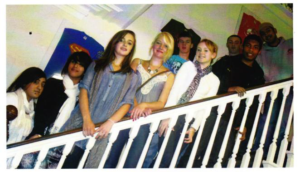 SPY Youth Committee was elected in 2010 to be a voice for all SPY members. In April 2011 the Youth Committee undertook a research and evaluation project. Members of the Committee commented that this gave them an opportunity to learn about how to conduct research, work as a team and collate information to help us make decisions and changes to our project. ‘Youth Truth’ was the name given to the research and evaluation. It was part of the evaluation undertaken after three years of funding from The Big Lottery for SPY which had provided exciting, challenging and fun activities which brought different communities together.
SPY Youth Committee was elected in 2010 to be a voice for all SPY members. In April 2011 the Youth Committee undertook a research and evaluation project. Members of the Committee commented that this gave them an opportunity to learn about how to conduct research, work as a team and collate information to help us make decisions and changes to our project. ‘Youth Truth’ was the name given to the research and evaluation. It was part of the evaluation undertaken after three years of funding from The Big Lottery for SPY which had provided exciting, challenging and fun activities which brought different communities together.
The research highlighted the following things which needed to be addressed:
- For every 4 young men there is one young woman accessing services: groups themselves were excluding young women. Although sessions were open to both male and female, young men were not welcoming or accommodating females. Some young women could not attend because of family restrictions in evening sessions, and families could discourage attendance due to sessions being mixed. This was a particular barrier for Asian young women.
- The girl’s work provided needed to be more challenging and exciting, with more physical activity.
- Young people said that more variety on sports, more work with juniors and more holiday activities were needed, they said that swimming sessions were too early, that some sessions clashed with mosque time, that there was some bullying and fighting and that advice and guidance could be better.
The Youth Committee committed to address these things in the following year and did so through to August 2012.
Research also highlighted the following:
 Young people really enjoyed what SPY offered
Young people really enjoyed what SPY offered- The staff were seen as friendly and fun.
- SPY created a nice feeling and made you part of the community
- 92% of young people thought SPY was good or excellent.
- SPY successfully got young people to try new activities, trips and training
- SPY helped with developing confidence and knowledge.
- All of this research was used as part of the evaluation of the Big Lottery Project.
